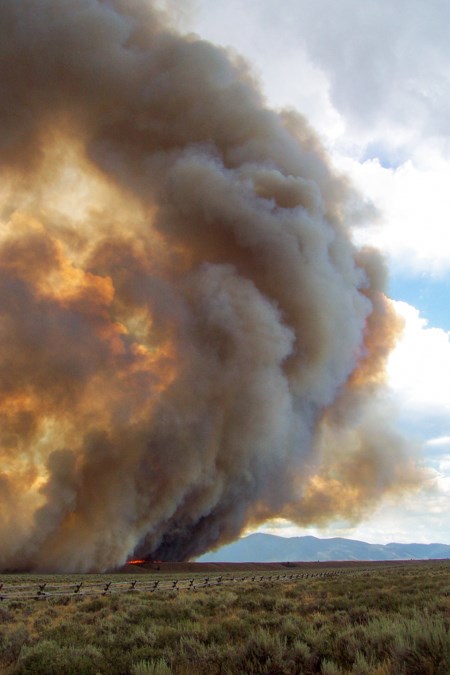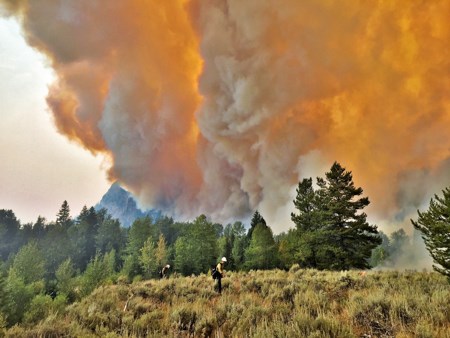
NPS Photo / CJ Adams
For millennia, indigenous people regularly and intentionally burned landscapes in the Northern Rockies. They set these fires for a variety of reasons, which included clearing undergrowth, creating wildlife habitat, supporting hunting strategies, reducing fire risk, and stimulating the growth of key food sources, such as huckleberries. As Anglo-Americans came into the west, they brought a fear of fire with them. They suppressed traditional burning practices, often banning them entirely. By the early 1900s, firefighting started to become formalized and consolidated under government land management agencies, like the U.S. Forest Service. The National Park Service was not founded until 1916, but members of the U.S. Army—including the famous Buffalo Soldiers—were dispatched to large parks like Yellowstone, Yosemite, and Glacier in the late 1800s and early 1900s to fight fires, among other duties. The extreme fire year of 1910, known as “The Big Burn”, was formative for fire managers. Over just a few days in late August, more than three million acres of forest burned in Idaho and Montana, killing over eighty people. This was seen as a major disaster at the time, both because of the loss of human life and the loss of timber, which was a valuable commodity. The legacy of the 1910 fires was the “10am rule,” which aimed to have every fire start put out by 10am the next day. Some prominent scientists and naturalists argued that fire played an important role in many ecosystems, but those voices were suppressed for several decades. By the 1970s, this policy of putting out every fire had led to a significant and unnatural buildup of fuels in some Western forests: live and dead trees, pine needles, shrubs, and grasses. In those places, scientists were beginning to notice impacts to critical species, particularly the famous sequoia trees of the Sierra Nevada. With further research, they discovered that fire played a critical role in regenerating these trees, clearing undergrowth and opening their cones to release seeds. Eastern parks, in particular Everglades National Park, had recognized even earlier that fire was critical to their pineland and prairie ecosystems. They began to use regular prescribed burns (fires set intentionally under certain conditions to accomplish natural resource goals) to maintain those habitats as early as the 1950s. Throughout the 1960s and 70s, scientists and managers worked to study the role of fire in ecosystems across the U.S. and reintroduce it to landscapes where it had long been absent. Waterfalls Canyon FireIn 1974, Grand Teton was the site of one of the earliest naturally-started fires that was allowed to burn in a national park. The Waterfalls Canyon Fire was started by lightning in mid-July, and the park superintendent and staff chose not to put it out, in accordance with new science-based policies. They monitored the fire’s growth carefully, and had plans in place in case it grew beyond the area where the park was comfortable having a fire. The fire was in a remote part of the park with no maintained trails, separated from developed areas by the four-mile width of Jackson Lake. It smoldered through July and August, increasing in size and intensity through September as autumn winds spread the fire. Autumn rains eventually put the fire out, after it burned 3,700 acres. 
Courtesy of the National Park Service, Grand Teton National Park archives (GRTE-00552) Learn more about the Waterfalls Canyon Fire in the Fire History Audio Tour, or explore the map of fire history below to see fires in the park over time. Post-1970sThe Waterfalls Canyon Fire highlighted tensions that continued to play out over the following decades. Scientists and managers recognized the need for fire on the landscape, but some spectators were frustrated by what they saw as “destruction” of beloved places. Even so, Grand Teton National Park and the Bridger-Teton National Forest both continued to allow fires under some circumstances—generally in remote locations. Several small and moderately-sized fires burned in the 1980s, most without significant incident. 
Courtesy of the National Park Service, Grand Teton National Park archives (GRTE-00552) One exception was the 1985 Beaver Creek Fire, which started just over a mile from a park housing area. The park immediately attempted to suppress it, but high winds pushed it rapidly to the east and north. The fire came very close to the park housing and destroyed a handful of historic cabins at the American Alpine Club Climber’s Ranch before heavy rains put it out. Looking forward, this incident likely informed the park’s emphasis on thinning fuels around developed areas. 1988 FiresAn incredibly dry and windy summer brought massive fires to the Greater Yellowstone Ecosystem in 1988, Grand Teton included. Nearly 1.5 million acres burned in and around Yellowstone, about half of which burned inside the park itself (about 800,000 acres, or a third of the park). Though relatively few acres burned within Grand Teton, the 5,500 acre Hunter Fire and the 119,000 acre Huck Fire both started in the park (they were non-natural starts, caused by power lines) and burned east onto the Bridger-Teton National Forest. Media coverage of the Yellowstone fires suggested that park management was just letting the fires burn. That was not the case, although the park’s fire policies did include allowing some to burn, while putting out others. In 1988, once it was clear that the extreme fire conditions would only lead to more fire growth, a massive firefighting effort involving over 10,000 people was focused on putting them out. Even so, under such unusually dry and windy conditions, the firefighting efforts had little effect on the overall acreage burned, and the fires went out when autumn snow arrived. (Explore Yellowstone’s page about the 1988 fires to learn more.) 
NPS Photo / D. Smaldone 1990s and 2000sThe 1990s and 2000s saw the development of a more robust fire management program in Grand Teton. In past years, fire work tended to be a side duty, in addition to a ranger’s normal job. But after 1988, leaders recognized the need for more specialized staff. Soon after, the park hired its first Fire Management Officer. With its more structured fire program, the park worked to accomplish the goals of allowing fire to play its natural role in the ecosystem, while providing for human safety and protecting the park’s developed areas. A key part of accomplishing both of those goals was reducing the density of vegetation around those developed areas, in order to slow a fire and dampen its behavior as it moved through. This work also allowed those areas to be more easily protected in a fire, which helped decision-makers to be more comfortable having natural fires on the landscape. A new Hazard Fuels Crew thinned vegetation around buildings by hand, and in some cases, managers used prescribed fire as well. The park conducted more than ten prescribed burns in the mid-90s and 2000s, with the two aims of a) reintroducing fire on the landscape to support natural processes, and b) removing fuels around developed areas to make them easier to defend in case of future fires. At the same time, lightning-ignited fires continued to burn on the landscape. Some were allowed to burn, under Prescribed Natural Fire policies (and later Wildland Fire Use policies), while others were suppressed by fire crews because of the potential danger they posed to park infrastructure or resources. The 90s were relatively quiet, with only one fire over 1,000 acres in the park—but in contrast, the 2000s had six. Most of these were on the west shore of Jackson Lake, where the presence of the lake as a fuel break and the lack of developed areas generally make it easier to allow fires to take their natural course. The Alder Fire, in 1999, was an important test of the newly-introduced hazard fuels management program. It started on the northwest side of Jenny Lake, and winds pushed it downslope toward the Jenny Lake Lodge. Fuels reduction efforts on the west side of the Jenny Lake Scenic Loop road allowed crews to hold the fire at the road, protecting the lodge. This was the first time fuels mitigation treatments were tested by wildfire within the park, and their success bolstered the program moving forward. In 1998, the park began monitoring the effects of fire with a dedicated crew. The team gathers data on how fire influences vegetation on the landscape—including recent fires, old fires, and a lack of fire. Their findings allow ecologists to track the effectiveness of our fire management program and contribute to a science-based approach. Throughout this period, changes to federal wildland fire policy provided more funding for fire programs, better safety measures for firefighters, and more flexibility in how staff could choose to manage fire. 
NPS Photo 2010sThe 2010s began with several quiet years, locally, although 2011, 2012, 2015, 2017, and 2018 have all been large fire years nationally. Here in the park, the 2010s have been defined by the Berry Fire, in 2016, which was our largest fire on record at over 20,000 acres. Watch a video about the Berry Fire. The fire started with a lightning strike and grew slowly through August, until strong winds pushed it across the northern end of Jackson Lake and the park highway, which was closed for several days. After the winds passed, fire behavior calmed again for a few weeks, until another wind event pushed it several miles up toward Flagg Ranch. Previous projects to thin the fuels around the developed area were effective in slowing the fire’s behavior, and crews were able to establish structure protection measures ahead of the fire, like installing sprinkler systems and removing additional vegetation. These efforts allowed the fire to pass through the developed area with minimal damage to buildings and infrastructure. Learn more about fire's role in our ecosystem on our Fire Ecology page, or return to the Wildland Fire homepage. |
Last updated: September 18, 2023
